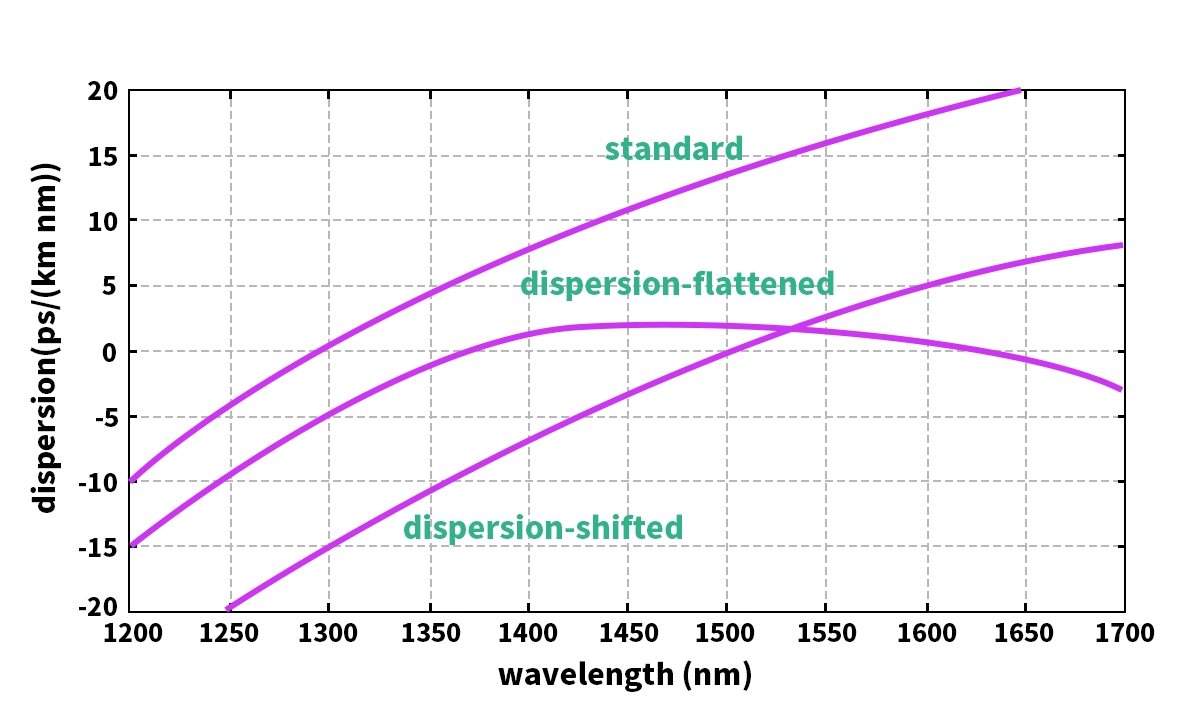
In the relentless pursuit of faster and more reliable data transmission, the backbone of our global internet—the humble optical fiber—has continuously evolved. While standard single-mode fibers revolutionized communication, they introduced a fundamental physical challenge: chromatic dispersion. This is where a specialized hero, Dispersion-Shifted Fiber (DSF), enters the scene, engineered to conquer this very limitation and pave the way for the long-haul, high-capacity networks we rely on today.
This article provides a comprehensive look at what DSF is, how it works, its different types, and its critical role in modern optical communication systems.
📝 Understanding the Problem: What is Chromatic Dispersion?
Before diving into DSF, we must understand the problem it solves. In optical fibers, chromatic dispersion (CD) is the phenomenon where different wavelengths (or colors) of light travel at slightly different speeds through the glass.
Imagine a group of runners starting a race together. Over a long distance, some runners (shorter wavelengths) will naturally pull ahead, while others (longer wavelengths) fall behind. The initial tight pulse of light spreads out, becoming broader and weaker.
➠ The Consequence: This pulse spreading causes inter-symbol interference, where adjacent bits of data blur into one another. For long-distance communication, this limits the data rate and the maximum achievable distance without signal regeneration.
Standard Single-Mode Fiber (SMF) has its zero-dispersion wavelength around 1310nm. However, the 1550nm window is highly prized because optical signals experience the least attenuation (signal loss) here. This created a dilemma: operate at 1310nm with low dispersion but higher loss, or at 1550nm with low loss but high dispersion? DSF was the elegant solution.
📝 What is Dispersion-Shifted Fiber (DSF)?
Dispersion-Shifted Fiber (DSF) is a type of single-mode optical fiber specifically designed to shift its zero-dispersion point from the natural 1310nm wavelength to the 1550nm window. By manipulating the fiber's core refractive index profile, engineers can "shift" the point where chromatic dispersion is zero to coincide with the point of minimum attenuation.
✅ The Core Achievement: DSF allows for high-data-rate transmission over exceptionally long distances in the 1550nm band by effectively minimizing the degrading effects of chromatic dispersion.

📝 How Does Dispersion-Shifted Fiber Work?
The magic of DSF lies in its sophisticated core design. While standard SMF has a simple step-index profile, DSF uses a more complex triangular or segmented core profile.
This design alters the waveguide dispersion component of the total chromatic dispersion. By carefully balancing the material dispersion (inherent to the glass) with the waveguide dispersion (created by the fiber's structure), the overall zero-dispersion wavelength is relocated to the desired 1550nm region.
📝 Types of Dispersion-Shifted Fibers
The initial DSF design was a breakthrough, but it introduced a new challenge in dense wavelength-division multiplexing (DWDM) systems: non-linear effects like Four-Wave Mixing (FWM). To address this, a second generation of fibers was developed.
The table below compares the key fiber types:
Fiber Type | Zero-Dispersion Wavelength | Key Characteristic | Primary Application |
|---|---|---|---|
Standard Single-Mode Fiber (SMF) | ~1310nm | Low dispersion at 1310nm, high loss at 1550nm. | Shorter reach applications, LAN/MAN. |
Dispersion-Shifted Fiber (DSF) | ~1550nm | Minimal dispersion & attenuation at 1550nm. | Single-wavelength long-haul systems. |
Non-Zero Dispersion-Shifted Fiber (NZ-DSF) | Shifted away from 1550nm (e.g., 1510-1580nm) | Low, but non-zero dispersion in the 1550nm band. | DWDM systems, suppresses non-linear effects. |
➠ NZ-DSF is the modern successor and is widely deployed in today's core networks. When professionals discuss optimizing networks for long-haul DWDM performance, they are often referring to the superior properties of NZ-DSF.
📝 Advantages and Real-World Applications
Key Advantages of DSF/NZ-DSF:
Extended Reach: Enables transmission over hundreds of kilometers without electronic regeneration.
Higher Data Rates: Supports 10G, 40G, 100G, and beyond by preserving signal integrity.
Optimized for EDFAs: Works perfectly with Erbium-Doped Fiber Amplifiers (EDFAs), which also operate in the 1550nm window.
Enhanced DWDM Capacity: NZ-DSF allows for packing more channels closely together, maximizing fiber capacity.
Primary Applications:
Long-Haul and Submarine Cable Systems
Metro and Regional Core Networks
High-Capacity Data Center Interconnects (DCI)
📝 The Critical Link: Optical Modules and DSF Integration
An optical fiber is only as good as the equipment that sends and receives light through it. This is where optical transceivers, or optical modules, become paramount. These devices convert electrical signals to optical signals and vice versa, and their performance must be perfectly matched to the fiber type for an optimal fiber optic network setup.
When deploying a network with Dispersion-Shifted Fiber, selecting the right optical module is non-negotiable. The module's operating wavelength, transmission power, and dispersion tolerance must align with the unique properties of DSF to achieve the desired high-speed data transmission.
This is where choosing a reliable manufacturer makes all the difference. For instance, LINK-PP produces a range of high-performance, compliant optical transceivers designed to unlock the full potential of advanced fiber infrastructures. A perfect match for DSF-based links is the LINK-PP SFP28-25G-ER module.
Why it's a great fit: The LINK-PP SFP28-25G-ER is a 25G transceiver operating in the 1310nm window with an extended reach of up to 40km. Its high performance and strict quality control ensure low dispersion penalty, making it an ideal solution for enhancing metro network capacity over NZ-DSF lines. Integrating such a high-quality module is a best practice for anyone looking to optimize WDM network design.
💡 Pro Tip: Always verify that your optical module's specifications (especially wavelength and chromatic dispersion characteristics) are compatible with your installed fiber plant (SMF, DSF, or NZ-DSF) to prevent performance issues.
📝 Conclusion
Dispersion-Shifted Fiber represents a pivotal innovation in optical communication. By intelligently manipulating fiber physics to align minimal dispersion with minimal loss, DSF and its successor, NZ-DSF, form the bedrock of our high-speed global internet backbone. Understanding its principles and its synergy with high-quality components like LINK-PP optical modules is essential for anyone designing, building, or managing the high-capacity networks of today and tomorrow.
As data demands continue to explode, the legacy of DSF's engineering will continue to light the way forward.
📝 FAQ
What is a dispersion-shifted fiber?
A dispersion-shifted fiber is a type of optical fiber. It lets you send light signals with less distortion. You also get lower signal loss. This fiber keeps your data clear and fast, even over long distances.
What makes dispersion-shifted fibers different from standard fibers?
DSFs have a zero-dispersion wavelength at 1.55 μm. Standard fibers have it at 1.3 μm. DSFs give you better signal quality and less loss at the main network wavelength.
What are the main benefits of using dispersion-shifted fibers?
You get clearer signals and faster data speeds. You can send data farther without losing quality. DSFs help you build strong networks for internet, phone, and video.
What should you check before choosing dispersion-shifted fibers?
Check if your equipment works with DSFs. Look at the cost and if it fits your system. Think about future upgrades. Some networks work better with other fiber types.
What problems can happen with dispersion-shifted fibers?
Sometimes signals can mix, like four-wave mixing. This can make your network quality worse. You might need extra equipment to fix these problems.


